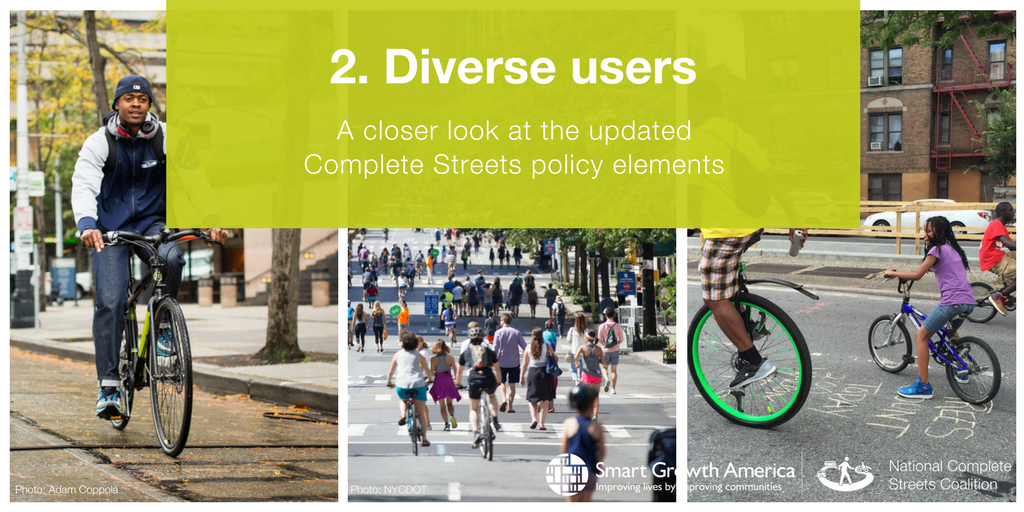
News
By Nimotalai Azeez, November 3, 2017

A Complete Streets approach requires “diverse users” to be more than just a buzzword. This brand new addition to our policy framework will hold jurisdictions accountable for including equity into their plans based on the composition and objectives of the community, a requirement that was lacking from the previous framework. The U.S. history of systemic discrimination and exclusion based on race and income is part of the transportation context and cannot be ignored. Transportation choices should be safe, convenient, reliable, affordable, accessible, and timely regardless of race, ethnicity, religion, income, gender identity, immigration status, age, ability, languages spoken, or level of access to a personal vehicle.
This post is part of Complete Streets month at Smart Growth America; we will be sharing a series of blog posts that cover and explain each of the 10 revised policy elements in some detail.
The best Complete Streets policies will specifically highlight and prioritize the communities of greatest concern. The communities that are disproportionately impacted by transportation policies and practices will vary depending on the context of the jurisdiction. Policies are not necessarily expected to list all of these groups. For example, some communities are more racially homogeneous but have extreme income disparities.
"The National Complete Streets Coalition adopted a new policy framework on diversity because we recognize the need for any community to take a holistic approach to planning transportation options in each neighborhood regardless of location," said Adriann Murawski, State & Local Government Affairs Representative at the National Association of REALTORS®. "The diversity element is critical as it requires the jurisdiction to “prioritize” vulnerable users or neighborhoods with histories of systematic disinvestment or underinvestment."
Tim Vaske, State and Community Advocacy Manager at American Heart Association – Voices for Healthy Kids shared some of his thoughts on the new policy element from the public health perspective:
Being able to safely walk, bike, take public transit and drive to the places where we live, work, learn, play and pray is critical to one’s overall health. Unfortunately, for millions of people living in the United States, the ability to safely move about is not an option. For decades multiple low-income communities and communities of color have lacked safe access to places of work, healthcare services, basic necessities such as healthy food, as well as routes to parks and schools. By prioritizing the diverse needs of the many communities when implementing Complete Streets policies, individuals and families will better be able to achieve and maintain a healthy lifestyle free from chronic diseases such as heart disease and diabetes.
“Diverse users” is just one of 10 policy elements that will be featured this month. We’ve officially revised our policy grading rubric, known as the 10 Elements of a Complete Streets Policy. The Complete Streets movement has evolved since it began in 2004 to focus far more on implementation and equity, but the framework for grading the quality of policies hasn’t kept pace. For months, a group of national stakeholders, consisting of engineers, planners, researchers, and advocates, worked to revise the policy elements and truly raise the bar for what Complete Streets look like in practice. The entire revised framework will be available on our website on November 30, 2017.
Stay tuned for more Complete Streets updates during the month of November
- Have questions about the changes? Join us as we discuss how the new grading rubric will affect future policies during our webinar on December 1, 2017 at 1:00pm ET. The entire new grading rubric resource will be released on our website shortly before the webinar. Register for the webinar today >>
- We are now accepting nominations for the Best Complete Streets initiatives. Do you know of a project, initiative, event, person, task force, etc. that exemplifies Complete Streets? Fill out this brief nomination form >>
If you have any questions about the changes to the Complete Streets policy framework, please contact us! We’re happy to discuss further.
Special thanks to our featured Steering Committee members:
 The National Association of REALTORS® is America's largest trade association, representing 1.2 million members, including NAR's institutes, societies, and councils, involved in all aspects of the residential and commercial real estate industries. REALTORS® support improving mobility in communities so that all citizens have access to transportation means best suited to their needs.
The National Association of REALTORS® is America's largest trade association, representing 1.2 million members, including NAR's institutes, societies, and councils, involved in all aspects of the residential and commercial real estate industries. REALTORS® support improving mobility in communities so that all citizens have access to transportation means best suited to their needs.

Voices for Healthy Kids is a joint initiative of the American Heart Association and Robert Wood Johnson Foundation. Our goal is to help all children achieve a healthy weight through increasing access to healthy, affordable foods and safe places for physical activity.
Related News

© 2025 Smart Growth America. All rights reserved
Site By3Lane Marketing











